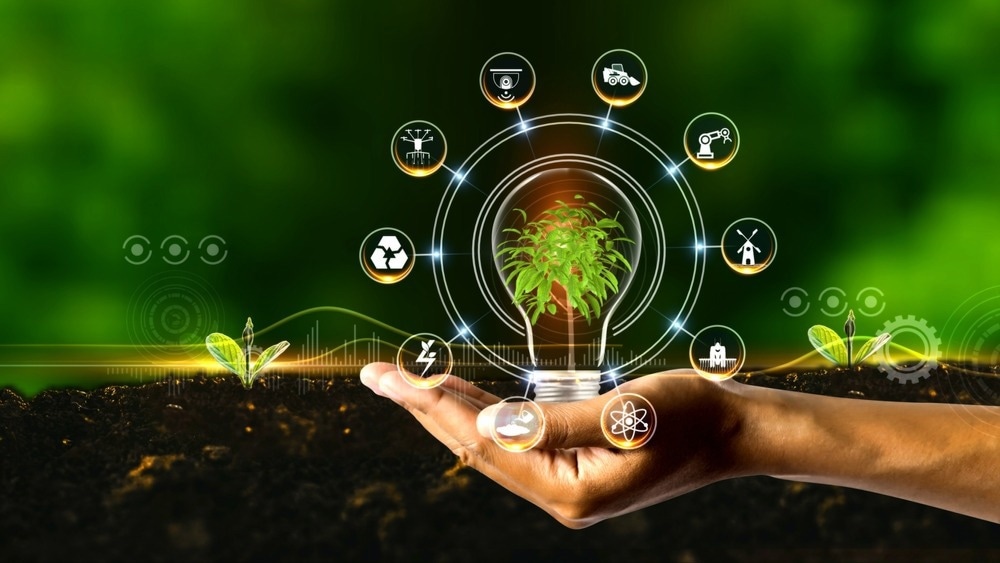Energy harvesting devices are gaining attention today as a key enabling technology for future Internet of Things (IoT) applications, particularly to help achieve so-called “trillion sensor systems” that passively and simultaneously monitor trillions of data points.

Image Credit: DSTUDIO9/Shutterstock.com
The technology uses various means to harvest energy as it dissipates around us in our bodies and our surrounding environment. Electromagnetic waves, dissipating heat, vibrations, and small-scale portable photovoltaic technologies are all under development or early release. These devices will help power the next generation of low-cost, environmentally friendly, nano- and microscale electronic devices.
Our surrounding environment includes numerous sources of dissipating energy that could be harvested with the correct application and technology. Energy harvesting devices are much more environmentally friendly than batteries traditionally deployed to remotely power small electronics.
The Internet of Things (IoT) and Industrial Internet of Things (IIOT) are technological paradigms that introduce sensing, computer processing, and connectivity technologies into ordinary objects. As a result, these objects become “smart,” or capable of autonomously recording, transmitting, and acting on local data.
The “trillion sensor” concept is a result of developments in IoT, making the deployment and operation of such an enormous array of sensors possible. Both of these concepts are well underway to be fully realized, with some predicting that we will deploy trillion sensor systems in a few years.
A key challenge is finding an appropriate means of powering smart, connected sensors and devices. Batteries tend to make up the bulk of IoT and sensor power sources. However, they have limited shelf lives, inefficiently use limited energy resources, and introduce form factor and weight constraints.
Trillion sensor networks demand an alternative to battery power, as replacing batteries in such vast sensor networks would be prohibitively complex and expensive and make any such network commercially unviable in the long term.
However, there have been numerous energy harvesting developments to tackle these challenges and introduce small-scale energy harvesting to individual sensors and IoT devices. This enables them to self-power without needing battery power and replacement or mains electricity.
Core-Shell Triboelectric Nanogenerator
Researchers from China’s Fuzhou University and Fujian Science and Technology Innovation Laboratory recently introduced a core-shell triboelectric nanogenerator (CS-TENG) for harvesting wind energy in a paper published in the journal Nanomaterials.
Nanogenerators convert the mechanical or thermal energy produced in small-scale physical changes into electricity. Types include piezoelectric, pyroelectric, and triboelectric generators.
Triboelectric nanogenerators were first demonstrated in 2012 by Georgia Institute of Technology researcher Dr. Zhong Lin Wang. The device converts external mechanical energy into electricity by combining triboelectric effects with electrostatic induction.
Potential is created in the inner circuit of the unit due to the triboelectric effect, which results from the charge transfer between two films with opposite tribo-polarity. Electrons in the outer circuit drive between electrodes on the back of the films to balance the potential. TENG devices are generally made from organic materials.
TENG technology is advanced in this new research by applying a core-shell structure. This means it can respond to wind sensitively as it comes from any direction and generates an electrical output.
Each CS-TENG device generates up to 0.14 W/m3, enough to power 124 LEDs. Wind as slow as 2.3 m/s can be harvested by paralleling different-sized CS-TENGs together.
The team built a self-powered water quality testing platform to demonstrate the applicability of the CS-TENG device. They found that the simple structure, environmentally friendly materials, low cost, and simple manufacturing process of the CS-TENG were advantageous and significant for developing environmentally friendly energy harvesting devices.
Organic Solar Cells
In recent energy harvesting developments, researchers from South China University of Technology demonstrated an organic solar cell with over 19% conversion efficiency and long-term stability. The research was published in Nature Energy.
The team altered the molecular chain length of a Y6-analogue and 2,2’-bithiophene unit, modifying its thermal properties, crystallization behavior, and molecular packing. They achieved optimal microstructure and stable morphology, resulting in a solar cell with over 19% efficiency and a 25,000-hour plus lifetime (equating to more than 16 years of operating capacity).
The team said that oligomeric strategy was essential in developing the organic solar cell and blend morphology. This enabled them to develop novel non-fullerene acceptors for stable, efficient organic solar cells.
Moisture-Induced Energy Harvesting
Another new device simultaneously harvests atmospheric moisture and sunlight to generate power and water. Researchers from Shanghai Jiao Tong University, China, published findings in a recent edition of Nature Communications.
They developed a moisture-induced energy harvesting platform. Using sorption-based atmospheric water harvesting alongside thermoelectric power generation, the team exploited synergistic effects to improve thermoelectric power density in the device by around 346%.
Advancing Perovskite Photovoltaics
Perovskite is emerging as a relatively cheap, accessible, and efficient solar cell material.
Researchers from China’s Nanjing Tech University and Northwestern Polytechnical University expanded the range of deposition methods for screen printing perovskite solar cells with perovskite ink.
Publishing results in the journal Nature, the team demonstrated fast printing rates, high levels of printing control, and efficiencies of 20.52% over 0.05 cm2 of material.
References and Further Reading
Chen, C., et al. (2022). Perovskite solar cells based on screen-printed thin films. Nature. doi.org/10.1038/s41586-022-05346-0
Li, T., et al. (2022). Simultaneous atmospheric water production and 24-hour power generation enabled by moisture-induced energy harvesting. Nature Communications. doi.org/10.1038/s41467-022-34385-4
Liang, Y., et al. (2022). Organic solar cells using oligomer acceptors for improved stability and efficiency. Nature Energy. doi.org/10.1038/s41560-022-01155-x
Wang, Q., et al. (2022). Omnidirectional Triboelectric Nanogenerator for Wide-Speed-Range Wind Energy Harvesting. Nanomaterials. doi.org/10.3390/nano12224046
Disclaimer: The views expressed here are those of the author expressed in their private capacity and do not necessarily represent the views of AZoM.com Limited T/A AZoNetwork the owner and operator of this website. This disclaimer forms part of the Terms and conditions of use of this website.